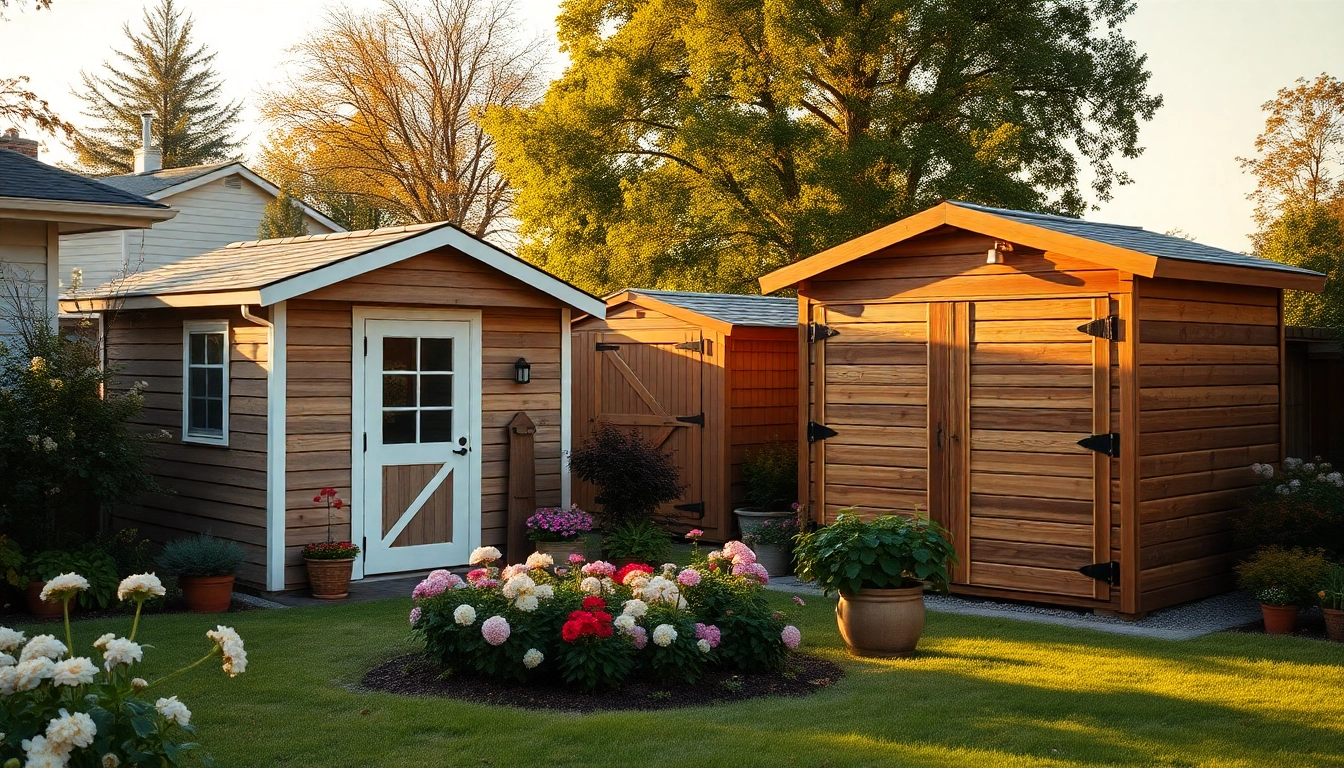Understanding Custom Built Storage Sheds
What Are Custom Built Storage Sheds?
Custom built storage sheds are tailored outdoor structures designed to meet the specific storage and utility needs of homeowners and businesses. Unlike pre-manufactured models, these sheds can be constructed in various configurations, sizes, and materials according to personal preferences. From simple tool storage units to intricate garden rooms or workshops, custom sheds can serve a plethora of purposes, adding functionality and aesthetic appeal to your property.
Benefits of Choosing Custom Solutions
One of the primary advantages of opting for custom built storage sheds lies in the ability to create a shed that fits perfectly with your requirements. Here are some key benefits to consider:
- Personalization: Homeowners can choose the design, materials, and dimensions according to their specific needs and style preferences.
- Quality Control: Custom builds usually involve higher standards of craftsmanship, ensuring the structure’s longevity and sturdiness.
- Maximized Space: Tailored sheds can be designed to utilize available space efficiently, making the most of your yard or garden area.
- Flexible Features: Features such as shelves, windows, doors, and electrical systems can be incorporated based on intended use.
Types of Custom Built Storage Sheds
Custom built storage sheds come in various types, each suited for different needs:
- Garden Sheds: Ideal for storing gardening tools, plants, and outdoor equipment. These can be designed to blend seamlessly with your landscaping.
- Workshops: Perfect for DIY enthusiasts or craftsmen looking for a dedicated space for projects, complete with workbenches and power outlets.
- Storage Units: Large sheds meant to store seasonal items, outdoor furniture, or bicycles securely.
- Playhouses: Custom-designed spaces for children’s play, equipped with windows and fun features.
- Garages: Additional parking space that can function as a classic garage or a storage space for vehicles and equipment.
Choosing the Right Design for Your Needs
Assessing Your Storage Requirements
Before diving into the design process, it’s crucial to assess your storage requirements. Consider the following:
- Items to Store: List the items you intend to store. This will help determine the size and type of shed you need.
- Space Available: Measure your yard space, keeping in mind local zoning laws and regulations.
- Accessibility: Think about how easy it will be to access the shed. Determine the best location that provides easy access to your stored items.
- Future Needs: Plan for future storage needs. A slightly larger shed might accommodate growth in your storage requirements.
Popular Design Styles for Custom Built Sheds
There are numerous design styles available for custom storage sheds. Some popular choices include:
- A-Frame Sheds: These feature a sloped roof that allows for quick rain drainage and spacious interiors. They’re a great choice for maintaining a classic look.
- Gable Sheds: Offering more vertical space, gable sheds are perfect for larger items or workspaces.
- Modern Sheds: Emphasizing sleek lines and minimalist designs, modern sheds can function as additional living spaces or creative studios.
- Victorian Sheds: Characterized by decorative features and intricate rooflines, these sheds add elegance to any property.
Integrating Features for Functionality
To enhance the utility of your custom storage shed, consider integrating various features during the design process:
- Windows & Ventilation: Natural light and airflow can make the shed a pleasant workspace.
- Electrical Outlets: Ideal for workshops, adding electricity will allow you to use power tools and lighting.
- Shelving and Cabinets: Built-in storage solutions maximize space and keep items organized.
- Paved Pathways: Create a clear path to the shed, which can be essential for easy access and functionality.
Materials and Construction Techniques
Common Materials Used in Custom Built Storage Sheds
The materials selected for your storage shed significantly affect its durability and aesthetic. Here are the most common choices:
- Wood: A classic choice for custom sheds, wood offers aesthetic versatility and excellent insulation but requires regular maintenance.
- Vinyl: Durable and maintenance-free, vinyl can replicate the look of wood without the upkeep.
- Metal: Aluminum or steel offers durability and protection from the elements, though they may not have the same aesthetic appeal as wood.
- Composite Materials: Engineered wood products provide the look of wood but with enhanced durability and moisture resistance.
Benefits of Professional Construction vs. DIY
When it comes to building a custom storage shed, you can either hire professionals or take the DIY route. Each has its advantages:
- Professional Construction: More expertise leads to higher quality builds, adherence to local codes, and often faster completion times.
- DIY: Offers personal satisfaction and can save on labor costs, but requires a solid understanding of construction methods, tools, and safety protocols.
Eco-Friendly Options for Sustainable Sheds
With increasing environmental awareness, many homeowners are looking for eco-friendly shed options. Sustainable materials and construction techniques include:
- Reclaimed Wood: Utilizing repurposed wood reduces waste and gives a unique character to your shed.
- Renewable Materials: Bamboo or sustainably sourced wood provide eco-friendly alternatives.
- Solar Panels: Adding solar panels can harness renewable energy, particularly useful for sheds being used as workshops.
Cost Analysis of Custom Built Storage Sheds
Initial Costs vs. Long-Term Value
Understanding the balance between initial costs and long-term value is vital when investing in a custom storage shed. Factors influencing costs include materials, design complexity, and added features such as electricity or insulation.
While a higher upfront investment can lead to better quality and longevity—resulting in less maintenance and replacement cost in the long run—budget-conscious buyers must weigh these factors carefully.
Factors Influencing Custom Shed Pricing
Several factors influence the pricing of custom built storage sheds:
- Size: Larger structures cost more to build.
- Material Choices: High-quality materials will raise costs but often enhance durability.
- Customization: Unique designs, features, and layouts require skilled labor and time, which can increase the price.
- Location: Building permits and geographic considerations may also affect costs due to varying local regulations and access to resources.
Financing Options and Budgeting Tips
Building a custom shed can involve substantial expenses, and budgeting becomes crucial. Here are key points to consider regarding financing:
- Savings: Utilize savings for an upfront payment to avoid debt.
- Loans: Home improvement loans can finance larger projects but be mindful of interest rates.
- Installment Plans: Some builders offer installment payment plans based on agreed milestones.
- Budgeting: Outline all potential costs ahead of time, including materials, labor, and any additional features.
Creating Your Perfect Storage Solution
Working with Shed Builders
Selecting the right shed builder can make all the difference. Here are steps to ensure a successful partnership:
- Research Options: Look for builders with strong reputations and customer reviews in your area.
- Ask for Portfolios: Review their previous work to understand their style and quality.
- Request Quotes: Obtain multiple quotes and understand what’s included in each price.
Steps to Design Your Shed
Designing your custom storage shed involves several steps:
- Visualize: Sketch your ideas, utilizing design software or consulting with your builder.
- Choose Materials: Based on durability, maintenance, and aesthetics.
- Plan Features: Finalize the exact features you wish to include.
- Finalize Budget: Set a firm budget while allowing for a contingency fund for unexpected expenses.
Maintaining and Enhancing Your Custom Built Shed
Maintenance is key to prolonging the life of your storage shed. Consider the following tips:
- Regular Inspections: Check for weather-related damage, mold, or pests.
- Surface Treatment: Depending on materials, apply suitable treatment to avoid rot or rust.
- Organization: Keep items organized inside the shed to prevent clutter and maximize space.



